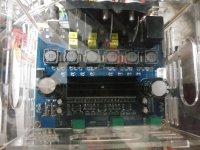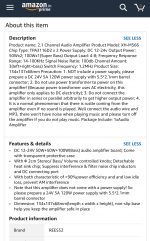N00bsta
Haven't ever done that but before I try, just want to know, the Current is to be measured at the input of the whole amplifier, that is through the Positive wire carrying the DC current from PSU to the amplifier?You should measure the current into the amp when playing music to verify this. If true, then theres no way to fix this except reducing the volume and/or using speakers with better efficiency.
I have a similar board, with dual TPA3116D2 chips, 3 channels, citing 2x50W and 1x100W. The issue I'm facing is that with amplifier volume set to 70-75% range, any increase in the Source (a DAC) beyond 60% of it's volume, the speakers stop momentarily during the playback like for a fraction of second. This keeps happening unless I turn down either the source volume or the amplifier volume. What could be the problem here? Source giving too much high powered signal, beyond the input sensitivity of the amplifier or the amplifier not powerful enough to handle the load?
The amplifier is connected to the source using RCA cables. It's being powered by the 90W Dell laptop PSU. I did try to swap it with a 24V 10A Switching PSU but the problem persisted.
It's pretty hard to trip the TPA3116's over current protection with anything less than a short. And since it's happening to all speakers (2.1 amp, correct), that means both chips are entering the fault at the same time. Pretty rare in my opinion. I think there's something else going on.
What impedance speakers are you using on the L-R and for the sub?
Also, a high resolution pic of the board from straight on top would help.
I faced similar issue with my other TPA3116 based Nobsound NS-01 Amplifier but upping the power supply worked then.It's pretty hard to trip the TPA3116's over current protection with anything less than a short. And since it's happening to all speakers (2.1 amp, correct), that means both chips are entering the fault at the same time. Pretty rare in my opinion. I think there's something else going on.
What impedance speakers are you using on the L-R and for the sub?
Also, a high resolution pic of the board from straight on top would help.
For the L-R channel, it's a pair of 6.5inch JBL Coaxial drivers rated at 4 Ohm 45W RMS while the Subwoofer unit is a pair of 4 inch 4 Ohm drivers rated at 40W RMS. They are wired in parallel so the effective impedance would be 2 Ohm. As for the pic, check the attachment. I didn't remove the plexiglass cover from the amplifier. If more clarity is needed in the pic, then will remove it and shoot it in daylight conditions.
Attachments
I faced similar issue with my other TPA3116 based Nobsound NS-01 Amplifier but upping the power supply worked then.
For the L-R channel, it's a pair of 6.5inch JBL Coaxial drivers rated at 4 Ohm 45W RMS while the Subwoofer unit is a pair of 4 inch 4 Ohm drivers rated at 40W RMS. They are wired in parallel so the effective impedance would be 2 Ohm. As for the pic, check the attachment. I didn't remove the plexiglass cover from the amplifier. If more clarity is needed in the pic, then will remove it and shoot it in daylight conditions.
Running at 24 V, I could see the 2 ohm parallel subs causing an over current protection fault at high volumes; doubtful it's the PS given its 10 A rating. Since the recovery is very quick, likely not over temperature (but who knows). There's a nice heat sink on the chips, hopefully with thermal paste. It's likely over current. I'd run a fan (of any sort) across the Plexiglas vents as a test to be sure. And remove the pair of 4 ohms on the sub channel to see if that clears the issue (with both the 10 A and the 90 W dell). That's what is confusing. The Dell PS is 19 V? That would really limit tripping any of the chips over protection safeties given my assumption it's a 19 V supply and the chip seems to have adequate cooling. Are you sure the 24 V 10 A supply lives up to its ratings?
Removed the Subwoofer and then played music. Still the same result. DAC volume was at 70% and Amplifier at almost 3/4th turn of the potentiometer. The plexiglass box is well vented and even after 3 hours of continuous playback, board has never got hot. So never felt the need of fan based active cooling. As for the 24V 10A SMPS, it was a Meanwell unit ordered from Amazon so I didn't double check it's rated parameters. Since it didn't provide the results I was expecting, I returned it. The board is still being powered by the 90W Dell power brick.Running at 24 V, I could see the 2 ohm parallel subs causing an over current protection fault at high volumes; doubtful it's the PS given its 10 A rating. Since the recovery is very quick, likely not over temperature (but who knows). There's a nice heat sink on the chips, hopefully with thermal paste. It's likely over current. I'd run a fan (of any sort) across the Plexiglas vents as a test to be sure. And remove the pair of 4 ohms on the sub channel to see if that clears the issue (with both the 10 A and the 90 W dell). That's what is confusing. The Dell PS is 19 V? That would really limit tripping any of the chips over protection safeties given my assumption it's a 19 V supply and the chip seems to have adequate cooling. Are you sure the 24 V 10 A supply lives up to its ratings?
Removed the Subwoofer and then played music. Still the same result. DAC volume was at 70% and Amplifier at almost 3/4th turn of the potentiometer. The plexiglass box is well vented and even after 3 hours of continuous playback, board has never got hot. So never felt the need of fan based active cooling. As for the 24V 10A SMPS, it was a Meanwell unit ordered from Amazon so I didn't double check it's rated parameters. Since it didn't provide the results I was expecting, I returned it. The board is still being powered by the 90W Dell power brick.
If it happens without the subs attached, then I don't think your problem is over current or heat related. With a 24 V supply, you actually running at 23.5 V due to the 0.5 V drop from the reverse polarity protection diode just behind the PS input to the left of the large DC PS bypass cap. At 23.5 V, each 8 ohm JBL will draw 33 W rms max. Well within the chips limits. And the Dell PS doesn't have enough power to cause a problem with exceeding the chip's limits.
Something else is wrong. Hard to tell without putting it up on a scope.
Could still be a problem with the filter stage being overdriven.
Could be. But that amount of current would create heat and he said the board remains cool. Maybe the inductors finally saturate and the current spikes before the TPA chips heat up?
Don't have the option to put it under scope. I have ordered a pair of Dayton Audio B652. If they deliver satisfactory audio output, might let things be. Else will try to swap the inductors, if that's advisable.
Could be a number of things. My inductor comment is SWAG and to see if Dr. Mord had an opinion.
Can you post a generic pic of your amp from the sellers site (or better, link to the seller's ad)? We're starting to use several of these amps on my other forum and I'm getting feedback. That might tell us if it's endemic to the amp's design or just a problem with your board.
I got it from Amazon so will share that link here. The seller on the Amazon has his own site too but the product isn't listed there. Judging from grammar of the item description on Amazon, looks like the seller just copy-pasted information from Alibaba, probably his source of the board in first place. Here's the link below and also screenshot of description.
REES52 2.1 Channel Audio Stereo Amplifier Subwoofer: Amazon.in: Electronics
REES52 2.1 Channel Audio Stereo Amplifier Subwoofer: Amazon.in: Electronics
Attachments
Last edited:
- Status
- This old topic is closed. If you want to reopen this topic, contact a moderator using the "Report Post" button.
- Home
- Amplifiers
- Class D
- Problems with amp and Bluetooth module.

